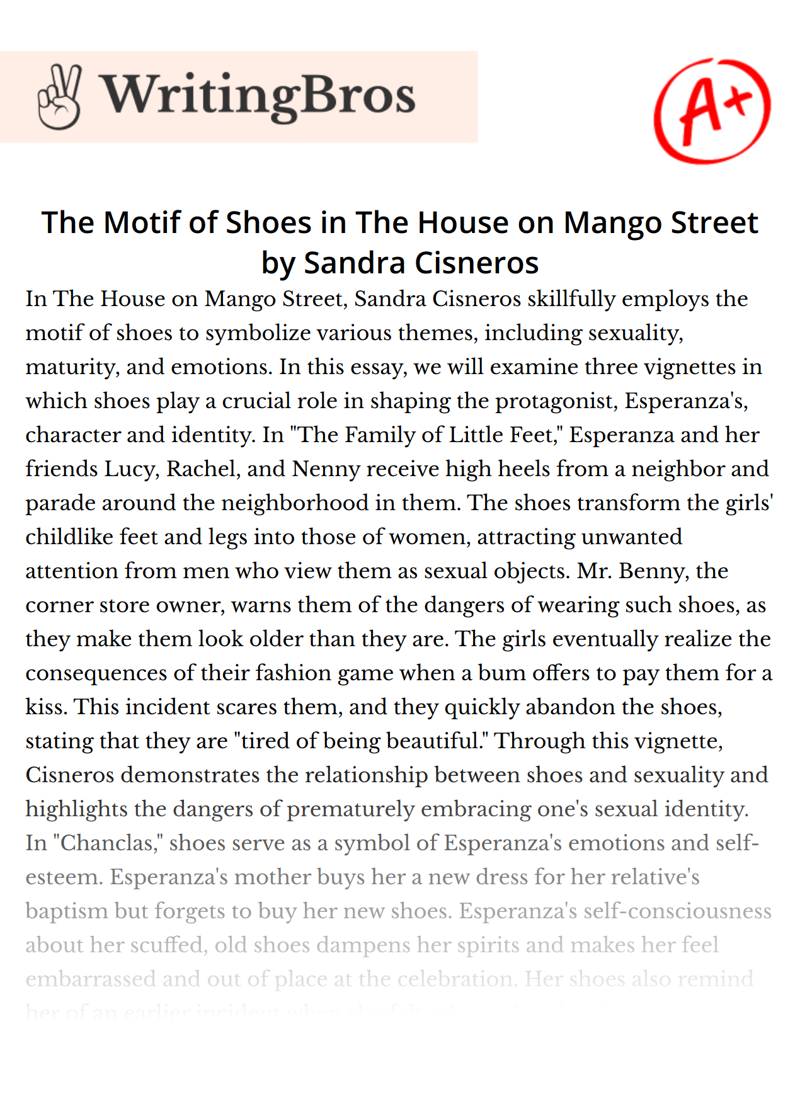The Motif of Shoes in The House on Mango Street by Sandra Cisneros

In The House on Mango Street, Sandra Cisneros skillfully employs the motif of shoes to symbolize various themes, including sexuality, maturity, and emotions. In this essay, we will examine three vignettes in which shoes play a crucial role in shaping the protagonist, Esperanza's, character and identity.
In "The Family of Little Feet," Esperanza and her friends Lucy, Rachel, and Nenny receive high heels from a neighbor and parade around the neighborhood in them. The shoes transform the girls' childlike feet and legs into those of women, attracting unwanted attention from men who view them as sexual objects. Mr. Benny, the corner store owner, warns them of the dangers of wearing such shoes, as they make them look older than they are. The girls eventually realize the consequences of their fashion game when a bum offers to pay them for a kiss. This incident scares them, and they quickly abandon the shoes, stating that they are "tired of being beautiful." Through this vignette, Cisneros demonstrates the relationship between shoes and sexuality and highlights the dangers of prematurely embracing one's sexual identity.
In "Chanclas," shoes serve as a symbol of Esperanza's emotions and self-esteem. Esperanza's mother buys her a new dress for her relative's baptism but forgets to buy her new shoes. Esperanza's self-consciousness about her scuffed, old shoes dampens her spirits and makes her feel embarrassed and out of place at the celebration. Her shoes also remind her of an earlier incident when she felt ashamed and embarrassed about them. Through this vignette, Cisneros illustrates how shoes can affect one's self-image and self-confidence, particularly during adolescence when one's identity is still in flux.
In "A House of My Own," shoes represent Esperanza's desire for independence and self-realization. In this vignette, Esperanza dreams of owning a house where she can escape from the constraints of Mango Street and create a space of her own. She envisions her dream house as a place where she can be free to pursue her interests and hobbies without worrying about societal expectations or pressure. Shoes, in this case, symbolize Esperanza's journey towards self-discovery and empowerment. She decides that she will no longer be treated as a sexual object and resolves to escape from Mango Street to achieve her dreams.
In conclusion, Sandra Cisneros skillfully uses the motif of shoes to explore complex themes such as sexuality, maturity, and emotions in The House on Mango Street. Through her use of shoes as a symbol, Cisneros effectively conveys the struggles and challenges that young women face in navigating their identities and finding their place in the world. As readers, we are left with a deeper understanding of the protagonist's journey towards self-discovery and empowerment.
References
- Cisneros, S. (1984). The House on Mango Street. Vintage.
- Fletcher, M. A. (2017). The House on Mango Street: A Retrospective. In The Fiction of Gloria Naylor: Houses and Spaces of Resistance (pp. 21-35). Palgrave Macmillan, Cham.
- Gurrero, E. R. (2019). Latina adolescence and body image in The House on Mango Street. The Journal of Popular Culture, 52(2), 384-399.
- Hidalgo, S. M. (2016). Intertextuality and Elaboration of Figures of Speech in Sandra Cisneros’ The House on Mango Street. Hispania, 99(1), 103-111.
- Korb, R. (1995). The symbolism of food in Sandra Cisneros' The House on Mango Street. MELUS, 20(4), 65-72.
Cite this Essay
To export a reference to this article please select a referencing style below

